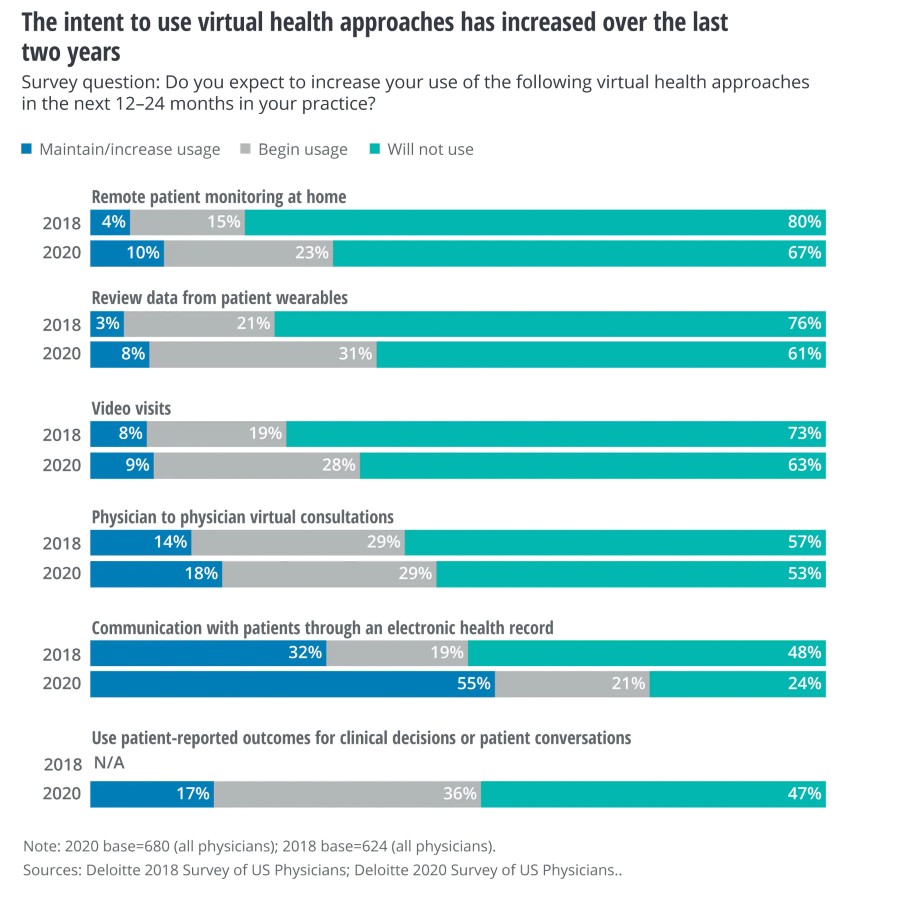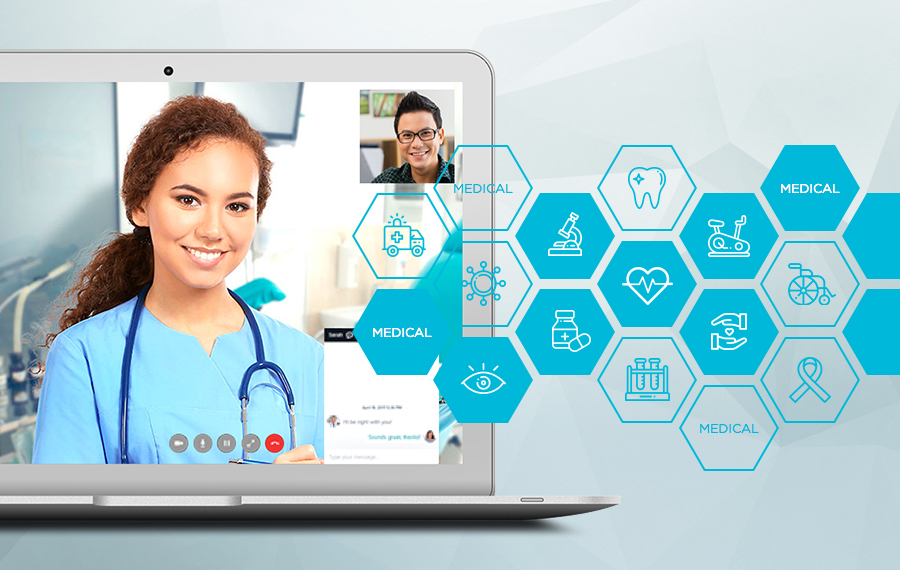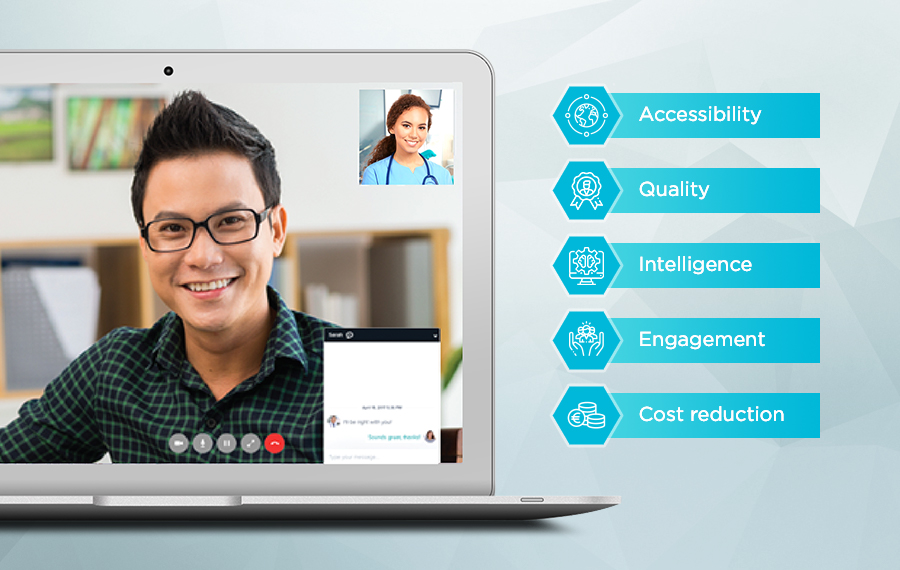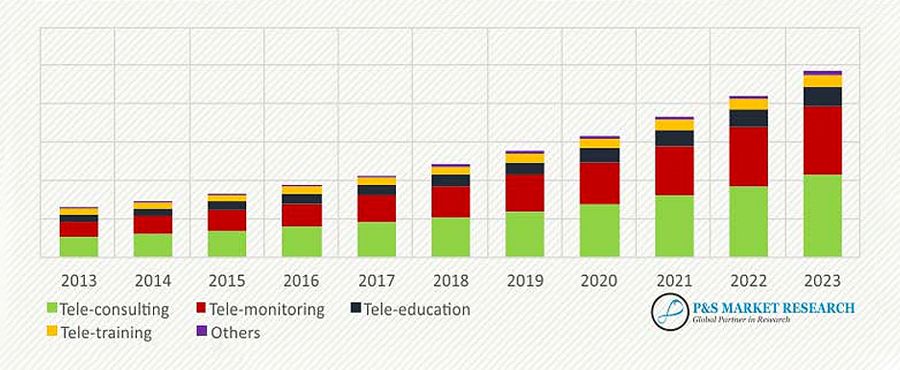Health is wealth they say. Could this be the motivation for developing more effective healthcare such as telemedicine?
Telemedicine in simple terms is the provision of medical care remotely by the combinational use of IT and telecommunications. It’s the enablement of healthcare providers with digital tools for distant medical consulting, assessing, diagnosing, and treating patients, health-related education, and administration.
“Telehealth technology has evolved to the point where virtual visits can now include entire care teams in ways that just aren’t possible when clinicians are using phones.”
— David McSwain, interim CMIO,
Medical University of South Carolina
The use of live-video consultations, remote monitoring, and virtual care helps achieve superior healthcare services and smooth patient access at a minimized cost, which is obviously a benefit for individuals and health insurance companies.
Telemedicine also provides healthcare organizations with the strategic advantage of a growing number of patients and hence getting more medical data. These are some key motivations that have led to the implementation of telemedicine apps and an increase in their use.

Source: Deloitte Insights
Applications of Telemedicine
There are various technologies involved in the support and development of telemedicine platforms to make them efficient and functional to suit the desired purposes. The use of wireless communications, video conferencing, streaming media, mobile technologies, IoT solutions and AI is very instrumental.
Learn more about the AI Uses in Healthcare
Let’s take a look how is telemedicine used in healthcare and talk about some of the most popular applications in this field.
Real-time Video Consultations
Real-time video consultation is an interactive live video session between a healthcare professional and a patient. It is a good alternative to a traditional visit to the doctor. It provides remote patients with easy access to healthcare services without a need for scheduling an in-person visit. This is a good advantage for patients in rural areas.
This type of consultation is quite effective for primary care, emergencies, outpatient, in-home care, acute care, and follow-up visits which usually do not need the physical presence of a doctor. For complicated issues and treatment, the doctor will advise visiting the hospital anyway.
Store-and-Forward Telemedicine
Store-and-forward telemedicine allows for collecting and sharing medical data such as health history, medical images, scans, and reports of a patient with a doctor or another specialist for assessment. This method also allows for a second opinion in data interpretation by third-party experts.
Store-and-forward telehealth is an asynchronous way of interaction. Doctors and patients don’t need to be present at the same time. It enables healthcare specialists to effectively attend to more patients, and make administrative work related to data easier.
Store-and-forward technology applies even more communication channels than real-time telemedicine software. It includes plain text, images, video and calls transcripts to name a few, all gathered together and securely transmitted.
There are various store-and-forward software platforms that help telemedicine services meet healthcare needs. For example, some of them enable users to fill out online forms regarding their health conditions. This data is then processed by a call center and passed to the on-call doctor who analyzes it and informs the user about diagnosis or treatment plan.
Remote Patient Monitoring
Remote patient monitoring is the use of technologies and medical devices to observe and monitor patients, while they are at home or any other place. That’s where the IoMT actively takes place. This method supports ambulatory healthcare. It enables real-time collecting and sharing of patients’ data.
RPM is mostly used to collect health information related to physiology such as blood sugar level, blood pressure or other important factors. A patient can conduct a routine test with a mobile medical device and send the test data to a specialist that will review the data in real-time.
The use of RMP is a good care option for elderly people, provisioning of post-acute care, support of chronic diseases, or cases such as cardiac issues, blood transfusions, pulmonary, and fetal medicine. Also known as telemonitoring, it is a comfortable option with better quality of care, support, and feedback. It ensures patients’ peace of mind and daily care, better access to services, and overall decreasing costs.
mHealth
mHealth is the use of mobile technologies and devices such as smartphones and tablets to effectively collect and share medical data, communicate public health information, and provide care. In other words, it’s the collaboration of healthcare and mobile communication technologies to enable:
- General health education
- Remote consultations
- Disease surveillance and treatment alignment
- Health data collection
- Drug reference and compliance issues
- Collaboration of health practitioners and researchers
A good example of mHealth solutions is a mobile app where a patient can access information on over-the-counter and other medications for early symptoms of minor illnesses, schedule an online consultation, and purchase medications with home or office delivery.
Applicable Specialties for Telemedicine

Today, telemedicine software development companies are focused on empowering healthcare professionals from various specialties with a wide range of digital services and opportunities. Let’s take a look at some examples.
Primary Care
When a live video or face-to-face contact is not necessary, approaches like store-and-forward telehealth aid general practitioners and primary care physicians in the diagnosis and medical consultations.
Moreover, store-and-forward telemedicine is commonly used for electronic consultations between physicians and specialists to share health data and discuss patient care.
Psychiatry
Telemedicine allows bringing more timely psychiatric care. Mental health services can be provided from anywhere without the limitation of distance. Video-based consultations, individual and group therapies, medication management, and educational functionality can be accessed via web and mobile applications.
The implementation of a telemedicine app allows a psychiatrist to see more patients without altering the standard of patient care. This can also reduce delays in care and improve the continuity of therapy. On top of that, it helps to control the number of absentees and cancellations of medical appointments.
Dermatology
With the aid of high-definition video and images from computers, smartphones or other mobile devices, dermatologists can examine cases of skin infections remotely. This can help patients that can’t leave the house to get medical attention through the use of telemedicine. It also saves patients with severe skin diseases the stress of traveling to a clinic.
Radiology
The need for radiologists to work with other medical experts reduces the efficiency of their job over time. Telemedicine software can help them to diagnose, treat patients, provide consultations, and collaborate with other experts from relatively anywhere at a faster rate. In other words, it enables radiologists with a well-streamlined process for sharing images and reports.
Endocrinology
Relying on the store-and-forward telemedicine, endocrinologists continuously monitor and modify treatment plans.
The level of hormones, glucose metrics, or pump data received from patients during the treatment can be easily transmitted between the team of healthcare professionals. Telehealth based on the store-and-forward approach is especially helpful when it comes to giving recommendations for rapidly changing scenarios at a moment’s notice.
Advantages of Telemedicine Technology in Healthcare
The benefits of telemedicine applications for healthcare service providers and patients are considerable. Here are some of the main advantages.

More Intelligent Solutions
Telemedicine is rapidly evolving and its impact in healthcare is getting higher. More and more technologies are applied in this industry to ensure high-quality health care delivery and management. There is always room for the sophistication of telemedicine with the use of new smart devices, communication technologies, artificial intelligence, blockchain solutions, and business process automation tools.
Moderm organizations get more intelligent tools to support their practice and patients, on the other hand, have more viable options to support their health.
Improved Healthcare Quality
Improved care quality is one of the key benefits that telemedicine brings to hospitals and medical organizations. According to ATA, services delivered through telemedicine are as good as traditional in-person consultations. At the same time, the general quality of services has increased with the use of telemedicine software.
For example, hospital admissions and cases of relapse have dropped. It’s much easier to follow up on patients without the need for the patients to be physically present at a hospital. Patients can easily get medical attention at the earliest symptoms.
Increased Patient Access
Telemedicine is aimed to provide healthcare services to consumers irrespective of distance. It improves access to medical care for patients in both rural and urban areas, especially if there is a lack of specialized health providers and facilities in their region. Telemedicine guarantees a safe and fast access to effective health care at any time of need.
Convenience, Satisfaction, and Engagement
The level of convenience to both patients and providers has seen a great leap with telemedicine software implementation. It naturally cuts out the waste of time in transportation for both healthcare providers and patients as the case may be.
Time loss to a missed appointment or trying to move patients that can’t walk is avoided. It is also a perfect crowd control for waiting room situations.
According to some reports, patient satisfaction and engagement have improved through the use of telemedicine. Patients are enjoying more flexibility and health service options.
Cost Efficiency
Besides cutting transportation expenses, as mentioned several times in this article, telemedicine helps significantly reduce the costs of effective remote management of chronic diseases and post-acute care. It facilitates shorter hospital stays, health education, and remote professional staffing or consultation.
Since telemedicine software is remotely operated, doctors can attend to patients from every and anywhere with lesser costs. Some doctors don’t even need a physical presence to practice their trade. Telemedicine can serve as a virtual hospital in this case. It allows the patient to schedule an appointment and even pay for the services received.
Trendiness
Most people love being able to do everything from a computer or mobile device and seeing a doctor is surely not an exception. Telemedicine is a perfect fit for a modern society living at a fast pace. It is comfortable to use. Therefore, people love it.
Accelerating Telemedicine Adoption
Telemedicine itself is more than just facilitation of interaction between a health specialist and a patient. It has grown as a form of virtual care emancipating it from limitations to become a necessity for healthcare. Through the guided aid of compliance technology and innovation, it has become a must-have.
Deployment of telehealth software services can be challenging. It requires following a strategic approach in care coordination, operational efficiency, data interoperability, and compliance with standard regulations. Velvetech specialists are experienced in custom healthcare software development and will gladly assist you. Get in touch with our consultants today and keep your business ahead.










